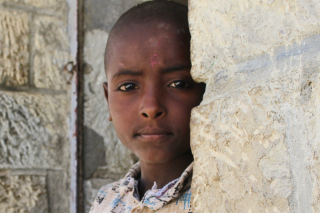
Crisis in Ethiopia: the cry of Tigray
Having lived through the atrocities of the war, millions of Ethiopians are now facing crisis levels of food insecurity and hunger.
The current situation in Ethiopia is dire. A combination of drought, displacement, and brutal conflict has left huge parts of the country in crisis, with Tigray, Amhara, and Afar regions among the worst affected. The two-year civil war that raged in and around Tigray has caused widespread destruction and left physical and mental scars on the people there, including millions of children – many of whom have missed years of schooling as a result.
For many months, colleagues from our local partner organisation have been sharing harrowing reports about the experiences of those in the communities they are supporting. Having lived through the atrocities of the war, millions of Ethiopians are now facing crisis levels of food insecurity and hunger. Most of Tigray is currently classified as having ‘emergency’ levels of acute food insecurity according to FEWS NET, using IPC-compatible analysis (IPC = Integrated Food Security Phase Classification).
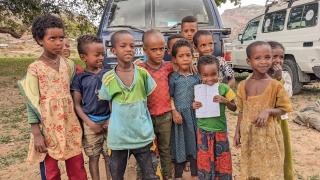
A clear risk of famine
The January 2024 Situation Report from OCHA (the UN Office for the Coordination of Humanitarian Affairs) estimates that more than 10 million people in Ethiopia will require food assistance this year.
Many of us will remember the famine in Ethiopia in the mid-1980s, which sparked memorable news coverage that inspired a worldwide fundraising effort and led to the 1985 Live Aid concert. Tigray was among the worst affected areas then, too.
The definition of famine is very precise (and certain criteria must be met before famine is declared in a region or country) so there is reluctance to use ‘the F word’ before the criteria have been met. However, reports from our local partner leave no question that extreme hunger is taking over the Tigray region and – unless major international intervention happens soon – it is only a matter of time before the situation will tick the necessary boxes to fulfil the technical definition of famine.
Getachew Reda, President of the Tigray Interim Regional Administration, recently told Channel 4 news: “…it is our responsibility to see to it that this unfolding famine doesn’t end up killing thousands, if not millions, because if we fail to address this problem, in time, whatever happened in 1985 would pale in comparison to what would happen now.” He went on to say: “I am in charge of the region and I see people dying of hunger”.
Sadly, this rings true with the devastating updates our colleagues have been sharing for several months.
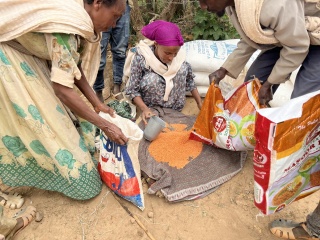
Learning loss and the future of education
During the conflict, warring parties attacked and looted schools in Tigray as well as using school buildings as military bases. As a result, some are no longer fit to be used as places of learning. (So far, Ethiopia has not endorsed the Safe Schools Declaration, which urges countries to take decisive action to protect schools and other educational facilities, including refraining from using them for military purposes.) Other schools – mostly in and around Mekelle – became shelters for internally displaced people escape from the fighting.
Millions of children were suddenly unable to go to school, finding themselves caught up in terrifying situations and often having to flee to displacement camps – or, in some cases, caves or other outdoor hiding places – just to survive. Our partner told us: “Children are so innocent, they didn't know why this was happening, they cannot comprehend. They cannot understand, but they end up in circumstances that are so unfavourable for children – they end up hungry, they end up living in different places. Parents would take them anywhere, just to keep them alive.”
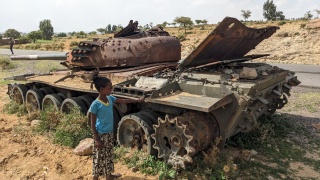
While schools were closed and our feeding programme had to be paused, our incredible partner worked tirelessly in very difficult circumstances and, with our support, delivered daily hot meals to more than 30,000 displaced people sheltering in camps. As people began to return home to their villages, our support continued in the form of community food distributions – again, made possible by the amazing work of our partner organisation.
As schools slowly began to open last year, our partner spoke of the “great longing” among children to return to classes. She said: “All these empty stomachs will have something to sustain them, children will have time and space to talk. It will be a reunion, to be able to see one another after years of separation, hopefully it will give them a relief.”
Speaking about how happy many children were to start back at school, she continued: “…because these children were out of school for four years, they were deprived of basic necessities. [Now they are] able to go to school and be able to be fed, to be able to get attention from teachers, attention from our staff members, and [spend time in] a place where they feel comfortable, where the environment is attractive to their needs, so they are really overjoyed and very happy to start their school.”
In recent months, many children have been able to return to school – albeit often in shell-riddled buildings with little or no equipment. Having done the necessary work to replace cooking equipment that was destroyed or looted during the conflict, we have now fully reinstated the school feeding programme in all the areas where we were serving Mary’s Meals (before the Covid-19 pandemic and subsequent civil war put a stop to all classes).
The war has undone years of progress in Tigray’s education system and the impact of millions of children missing years of learning is sure to be huge. For now, there is an urgent dual priority – ensuring that children in Tigray don’t starve and boosting their chances of engaging with education again.
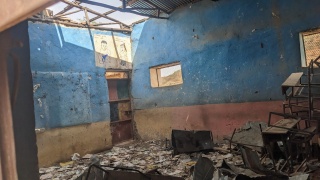
How you can help
We are acutely aware of the desperate need among children in Tigray, Ethiopia, for consistent meals and the chance to learn. Our partner is ready to extend the programme to more schools, in areas of great need across the region. We will work together, as funds allow, to reach tens of thousands more children with daily meals in school over the coming weeks and months.
As our partner so movingly questions: “…if you don’t help people from starving, from dying, now, when are you going to do it? Tomorrow is too late. I really hope something tangible would be done to save the lives of people who are dying of hunger, especially now, in Ethiopia and particularly in Tigray.”
Please donate today.
